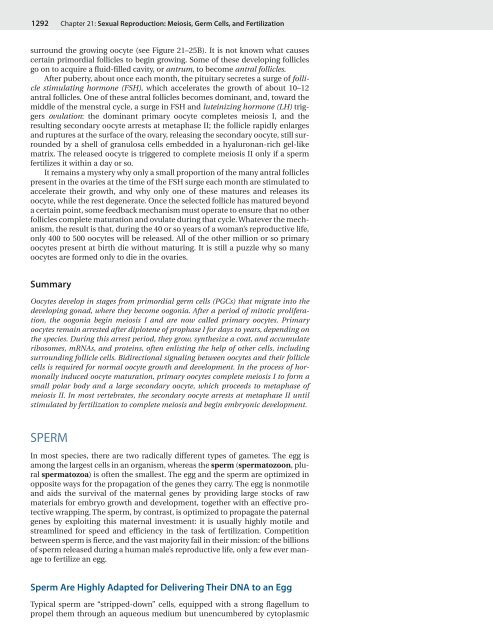Sexual Reproduction: Meiosis, Germ Cells, and ... - U-Cursos
Sexual Reproduction: Meiosis, Germ Cells, and ... - U-Cursos
Sexual Reproduction: Meiosis, Germ Cells, and ... - U-Cursos
You also want an ePaper? Increase the reach of your titles
YUMPU automatically turns print PDFs into web optimized ePapers that Google loves.
1292 Chapter 21: <strong>Sexual</strong> <strong>Reproduction</strong>: <strong>Meiosis</strong>, <strong>Germ</strong> <strong>Cells</strong>, <strong>and</strong> Fertilizationsurround the growing oocyte (see Figure 21–25B). It is not known what causescertain primordial follicles to begin growing. Some of these developing folliclesgo on to acquire a fluid-filled cavity, or antrum, to become antral follicles.After puberty, about once each month, the pituitary secretes a surge of folliclestimulating hormone (FSH), which accelerates the growth of about 10–12antral follicles. One of these antral follicles becomes dominant, <strong>and</strong>, toward themiddle of the menstral cycle, a surge in FSH <strong>and</strong> luteinizing hormone (LH) triggersovulation: the dominant primary oocyte completes meiosis I, <strong>and</strong> theresulting secondary oocyte arrests at metaphase II; the follicle rapidly enlarges<strong>and</strong> ruptures at the surface of the ovary, releasing the secondary oocyte, still surroundedby a shell of granulosa cells embedded in a hyaluronan-rich gel-likematrix. The released oocyte is triggered to complete meiosis II only if a spermfertilizes it within a day or so.It remains a mystery why only a small proportion of the many antral folliclespresent in the ovaries at the time of the FSH surge each month are stimulated toaccelerate their growth, <strong>and</strong> why only one of these matures <strong>and</strong> releases itsoocyte, while the rest degenerate. Once the selected follicle has matured beyonda certain point, some feedback mechanism must operate to ensure that no otherfollicles complete maturation <strong>and</strong> ovulate during that cycle. Whatever the mechanism,the result is that, during the 40 or so years of a woman’s reproductive life,only 400 to 500 oocytes will be released. All of the other million or so primaryoocytes present at birth die without maturing. It is still a puzzle why so manyoocytes are formed only to die in the ovaries.SummaryOocytes develop in stages from primordial germ cells (PGCs) that migrate into thedeveloping gonad, where they become oogonia. After a period of mitotic proliferation,the oogonia begin meiosis I <strong>and</strong> are now called primary oocytes. Primaryoocytes remain arrested after diplotene of prophase I for days to years, depending onthe species. During this arrest period, they grow, synthesize a coat, <strong>and</strong> accumulateribosomes, mRNAs, <strong>and</strong> proteins, often enlisting the help of other cells, includingsurrounding follicle cells. Bidirectional signaling between oocytes <strong>and</strong> their folliclecells is required for normal oocyte growth <strong>and</strong> development. In the process of hormonallyinduced oocyte maturation, primary oocytes complete meiosis I to form asmall polar body <strong>and</strong> a large secondary oocyte, which proceeds to metaphase ofmeiosis II. In most vertebrates, the secondary oocyte arrests at metaphase II untilstimulated by fertilization to complete meiosis <strong>and</strong> begin embryonic development.SPERMIn most species, there are two radically different types of gametes. The egg isamong the largest cells in an organism, whereas the sperm (spermatozoon, pluralspermatozoa) is often the smallest. The egg <strong>and</strong> the sperm are optimized inopposite ways for the propagation of the genes they carry. The egg is nonmotile<strong>and</strong> aids the survival of the maternal genes by providing large stocks of rawmaterials for embryo growth <strong>and</strong> development, together with an effective protectivewrapping. The sperm, by contrast, is optimized to propagate the paternalgenes by exploiting this maternal investment: it is usually highly motile <strong>and</strong>streamlined for speed <strong>and</strong> efficiency in the task of fertilization. Competitionbetween sperm is fierce, <strong>and</strong> the vast majority fail in their mission: of the billionsof sperm released during a human male’s reproductive life, only a few ever manageto fertilize an egg.Sperm Are Highly Adapted for Delivering Their DNA to an EggTypical sperm are “stripped-down” cells, equipped with a strong flagellum topropel them through an aqueous medium but unencumbered by cytoplasmic
















